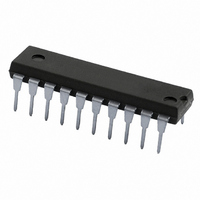SAA6588/V2,112 NXP Semiconductors, SAA6588/V2,112 Datasheet - Page 7

SAA6588/V2,112
Manufacturer Part Number
SAA6588/V2,112
Description
IC RDS/RBDS PRE-PROCESSOR 20DIP
Manufacturer
NXP Semiconductors
Datasheet
1.SAA6588TV2H518.pdf
(32 pages)
Specifications of SAA6588/V2,112
Function
Pre-Processor
Frequency
57kHz
Package / Case
20-DIP (0.300", 7.62mm)
Lead Free Status / RoHS Status
Lead free / RoHS Compliant
Other names
935261513112
SAA6588N
SAA6588N
SAA6588N
SAA6588N
Philips Semiconductors
RDS/RBDS block detection
The RDS/RBDS block detection is always active.
For a received sequence of 26 data bits, a valid block and
its offset are identified via syndrome calculation.
During synchronization search, the syndrome is calculated
with every new received data bit (bit-by-bit) for a received
26-bit sequence. If the decoder is synchronized, syndrome
calculation is activated only after 26 data bits for each new
block received.
Under RBDS reception situation, beside the RDS block
sequences with (A, B, C/C', D) offset also block sequences
of 4 blocks with offset E may be received. If the decoder
detects an E-block, this block is marked in the block
identification number BL and is available via an I
request. In RBDS processing mode the block is signed as
valid E-block and in RDS processing mode, where only
RDS blocks are expected, signed as invalid E-block
(see Table 13).
This information can be used by the main controller to
detect E-block sequences and identify RDS or RBDS
transmitter stations.
Error detection and correction
The RDS/RBDS error detection and correction recognizes
and corrects potential transmission errors within a
received block via parity-check in consideration of the
offset word of the expected block. Burst errors with a
maximum length of 5 bits are corrected with this method.
After synchronization has been found the error correction
is always active, but cannot be carried out in every
reception situation.
During synchronization search, the error correction is
disabled for detection of the first block and is enabled for
processing of the second block depending on the
pre-selected error correction mode for synchronization
(mode SYNCA to SYNCC, see Table 4).
The processed block data and the status of error
correction are available for data request via the I
the last two blocks.
Processed blocks are characterized as uncorrectable
under the following conditions:
2002 Jan 14
During synchronization search, if the burst error is
higher than allowed by the pre-selected correction
mode.
After synchronization has been found, if the burst error
is higher than 5 bits or if errors are detected but error
correction is not possible.
RDS/RBDS pre-processor
2
C-bus for
2
C-bus
7
Synchronization
The decoder is synchronized if two successive valid blocks
in a valid sequence are detected by the block detection.
For detection of the second block of this sequence, error
correction is also enabled depending on the pre-selected
correction mode (see Table 4). Only valid (correctable)
blocks are accepted for synchronization (see also Section
“Error detection and correction”).
If synchronization is found, the synchronization status flag
(SYNC) is set and available via an I
The synchronization is held until the flywheel (for
synchronization hold) detects a loss of synchronization
(see Section “Flywheel for synchronization hold”) or an
external restart of synchronization is performed (see
Section “Data processing control”).
Flywheel for synchronization hold
For a fast detection of loss of synchronization the internal
flywheel counter checks the number of uncorrectable
blocks (error blocks). Error blocks increment and valid
blocks decrement the block error counter.
The flywheel counter is only active if the decoder is
synchronized. The synchronization is held until the
flywheel counter detects an error block overflow (loss of
synchronization). The maximum value for the error block
counter is adjustable via the I
(see Table 6).
The value 32 is set after reset and the values 0 and 63
have a special function.
Bit slip correction
During poor reception situation phase shifts of one bit to
the left or right ( 1 bit slip) between the RDS/RBDS clock
and data may occur, depending on the lock conditions of
the demodulators clock regeneration.
If the decoder is synchronized and detects a bit slip, the
synchronization is corrected by +1 or 1 bit via block
detection on the respectively shifted expected new block.
If the value 0 is programmed then no flywheel is active
If the value 63 is programmed then the flywheel is
endless and no new start of synchronization is effected
automatically (synchronization hold).
2
C-bus in a range of 0 to 63
2
C-bus request.
Product specification
SAA6588














